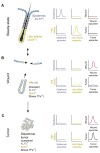The epigenetic basis of cellular plasticity
- PMID: 29413970
- PMCID: PMC5949887
- DOI: 10.1016/j.ceb.2018.01.003
The epigenetic basis of cellular plasticity
Abstract
Cellular plasticity is now recognized as a fundamental feature of tissue biology. The steady-state differentiation of stem and progenitor cells into mature cells is, in itself, the index form of cellular plasticity in adult organisms. Following injury, when it is critical to quickly regenerate and restore tissue integrity and function, other types of cellular plasticity may be crucial for organismal survival. In these contexts, alterations in the epigenetic landscape of tissues are likely to occur in order to allow normally restricted cell fate transitions. Epigenetic mechanisms, particularly DNA methylation and histone modifications, have been shown to play an important role in regulating such plasticity. Relevant mechanisms have been well studied in the context of the direct reprograming of somatic cells into induced pluripotent stem cells. Indeed, epigenetic regulation of cell fate is part and parcel of normal embryonic development and is a central regulator of cellular diversity. This is normally thought to involve the establishment of divergent chromatin patterns that culminate in cells with distinct and what were previously thought to be irreversible fates. This brief review aims to put some of these new observations in the larger context of regeneration after injury.
Published by Elsevier Ltd.
Figures


References
-
- Waddington CH. The strategy of the genes. George Allen Unwin Ltd; 1957.
-
- Rajagopal J, Stanger BZ. Perspective Plasticity in the Adult : How Should the Waddington Diagram Be Applied to Regenerating Tissues. Dev Cell. 2016;36:133–137. This review revisits the Waddington diagram in the context of cellular plasticity during adult regeneration. It suggests that the epigenetic landscape in adult tissues must be dynamic to facilitate the cellular plasticity that is required following injury. - PubMed
Publication types
MeSH terms
Grants and funding
LinkOut - more resources
Full Text Sources
Other Literature Sources

